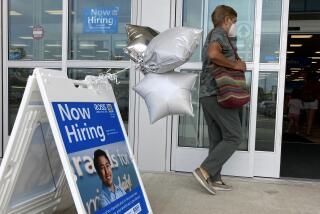Growth in worker efficiency slows
- Share via
WASHINGTON — The efficiency of America’s workers grew at a slightly slower pace in the spring as companies sought to produce more with leaner workforces. Compensation growth slowed too.
The Labor Department reported Friday that productivity -- worker output per hour -- grew at an annual rate of 2.2% during the April-through-June quarter. That was down from 2.6% in the first three months of this year.
Economists were forecasting productivity growth to pick up slightly to a 2.7% pace.
“The economy is limping along and businesses are doing whatever they can to remain competitive,” said Joel Naroff, president of Naroff Economic Advisors. “So we had fewer people working shorter hours and producing more.”
Meanwhile, growth in compensation -- wages and benefits -- also slowed as companies were less generous amid troubles in the economy and uncertainty about their own prospects.
Unit labor cost growth slipped to a 1.3% pace in the second quarter, from 2.5% in the first quarter. Unit labor costs measure how much companies pay workers for every unit of output they produce. Economists look to this barometer for clues about inflation.
The showing on compensation matched economists’ expectations.
While slower compensation growth isn’t welcomed by workers, economists said the moderation eases some inflation concerns. Back in the 1970s, the country battled “stagflation,” a mix of stagnant growth and stubborn inflation. Workers demanded -- and received -- higher wages to keep up with ever-rising prices.
The economy grew at a 1.9% pace in the second quarter, up from a 0.9% growth rate in the first three months of this year. The economy’s growth rate reflects the value of all goods produced in the United States. During the second quarter -- as has happened all year-- employers cut jobs.
Inflation continues to eat into workers’ paychecks. Compensation for each hour worked, adjusted for inflation, fell at a 1.4% pace in the second quarter. That compares with 0.8% in the first quarter.
More to Read
Inside the business of entertainment
The Wide Shot brings you news, analysis and insights on everything from streaming wars to production — and what it all means for the future.
You may occasionally receive promotional content from the Los Angeles Times.










